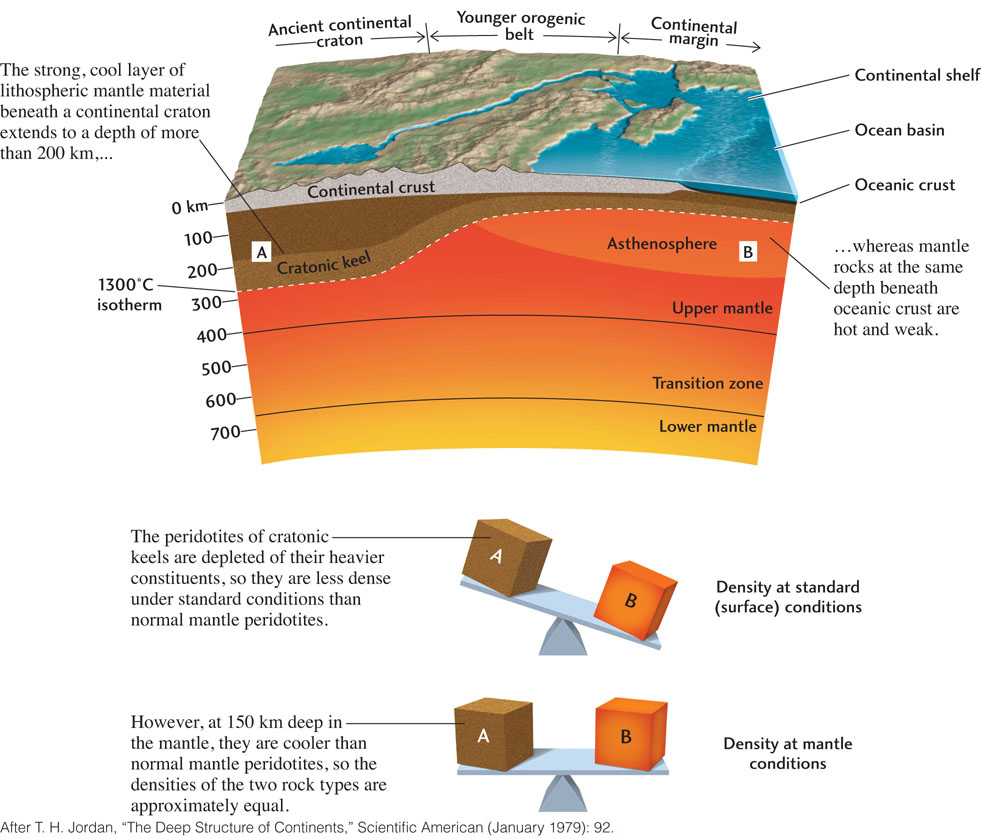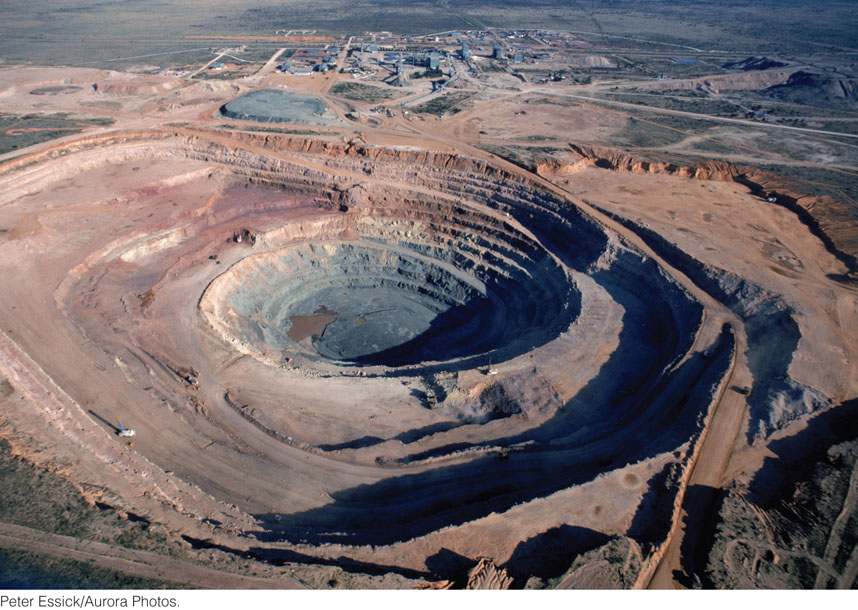The Deep Structure of Continents
In this chapter, we have surveyed the most important processes in the development of Earth’s continental crust. However, we have not yet explained one very basic aspect of continental behavior: the long-term stability of the cratons. How have the cratons survived being knocked around by plate tectonic processes for billions of years? The answer to this question lies not in the crust, but in the lithospheric mantle below it.
Cratonic Keels
By using seismic waves to “see” into Earth’s interior, geologists have discovered a remarkable fact: the continental cratons are underlain by a thick layer of mechanically strong mantle material that moves with the cratons as the continents drift. These thickened sections of lithosphere extend to depths of more than 200 km—more than twice the thickness of the oldest oceanic lithosphere.
At 100 to 200 km beneath oceanic crust (as well as beneath most younger regions of the continents), the mantle rocks are hot and weak. They are part of the ductile asthenosphere, which flows relatively easily, allowing the plates to slide across Earth’s surface. The lithosphere beneath the cratons extends into this region like the hull of a boat into water, so we refer to these mantle structures as cratonic keels, as shown in Figure 10.24. All cratons on every continent appear to have such keels.

Cratonic keels present many puzzles that scientists are still trying to solve. Less heat is emitted from the mantle beneath the cratons than from the mantle beneath oceanic crust. This observation indicates that the keels are several hundred degrees cooler than the surrounding asthenosphere, which explains their strength. If the rocks of the mantle beneath the cratons are so cool, however, why don’t they sink into the mantle under their own weight, as cold, heavy slabs of oceanic lithosphere do in subduction zones?
277
Composition of the Keels
The cratonic keels would indeed sink into the mantle if their chemical composition were the same as that of ordinary mantle peridotites. To get around this problem, geologists have hypothesized that the cratonic keels are made of rock with a different, less dense chemical composition (see Figure 10.24). Their lower density counteracts the increase in density resulting from their cooler temperature.
Strong evidence in support of this hypothesis has come from mantle samples found in kimberlite pipes—the same types of volcanic deposits that produce diamonds, as we will see in Chapter 12. Kimberlite pipes are the eroded necks of volcanoes that have erupted explosively from tremendous depths (Figure 10.25). Almost all kimberlites that contain diamonds are located within the Archean regions of cratons. A diamond will revert to graphite at depths shallower than 150 km unless its temperature drops quickly. Therefore, the presence of diamonds in these pipes shows that the kimberlite magmas came from deeper than 150 km, and that they erupted through the keels when magma fractured the lithosphere very rapidly.

During a violent kimberlite eruption, fragments of the cratonic keel, some containing diamonds, are ripped off and brought to the surface in the magma as mantle xenoliths. The majority of these xenoliths turn out to be peridotites containing less iron (a dense element) and less garnet (a dense mineral) than ordinary mantle peridotites. Such rocks can be produced by extraction of a basaltic (or komatiitic) magma from the asthenosphere by partial melting. In other words, the mantle rock beneath the cratons is the depleted residue left over after melting sometime earlier in Earth’s history. A cratonic keel made of such depleted rocks can still float atop the mantle, despite its cooler temperature (see Figure 10.24).
278
Age of the Keels
By analyzing xenoliths from kimberlites and the diamonds they contain, we have learned that the cratonic keels are about the same age as the Archean crust above them. (The diamond in your ring or necklace is likely to be several billion years old!) Therefore, the rocks now present in the cratonic keels must have been depleted by the extraction of a basaltic melt very early in Earth’s history, and they must have been positioned beneath the Archean crust about the time that crust was stabilized.
In fact, keel formation was probably responsible for the tectonic stabilization of the cratons. The existence of a cool, mechanically strong keel explains why the cratons have managed to survive through many continental collisions, including at least four episodes of supercontinent formation, without much internal deformation.
Many aspects of this process are still not understood. How did the keels cool down? How did they achieve the density balance illustrated in Figure 10.24? Why are the regions of the cratons with the thickest keels of Archean age? Some scientists believe that the continents play a major role in the mantle convection that drives the plate tectonic system, but how the keels affect convection in the mantle is not completely understood. Indeed, many of the ideas presented in this chapter are hypotheses that have not yet been integrated into a fully accepted theory of continental evolution and deep structure. The search for such a theory remains a central focus of geologic research.